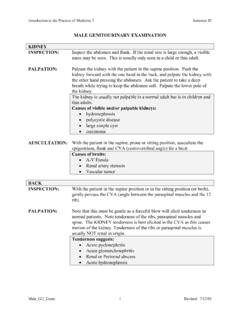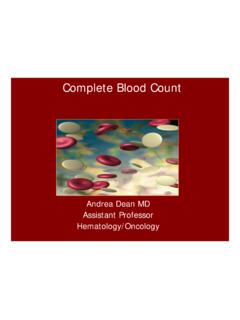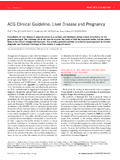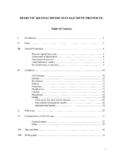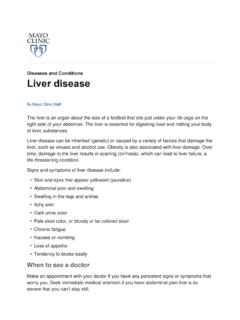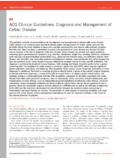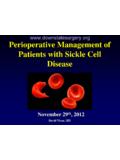Transcription of Assessment of Liver Function and Diagnostic Studies
1 Assessment of Liver Function and Diagnostic Studies2011 Joseph Ahn, , Professor of MedicineMedical Director, Liver Absolute AutopsyKey Points1. Review the components of Liver Function tests (LFTs)2. Develop an understanding of Diagnostic tests for Liver disease 3. Formulate a Diagnostic approach to assessing abnormal LFTsThe Liver Largest internal organ Has more functions than any other organ Can sustain life even when only 10-20% of Liver tissue is functioningThe Liver Weighs 1,200 to 1,500 grams. Dual blood supply: portal vein brings venous blood from the intestines and spleen (2/3) Hepatic artery rises from the celiac axis (1/3) General Clinical Definitions Acute Liver disease: Liver disease of 8 weeks duration or less.
2 Subacute Liver disease: Liver disease 8 weeks - 6 months duration. Chronic Liver disease or chronic hepatitis: Abnormal Liver chemistries > than six Definitions-continued Liver failure-Failure of the Liver to perform its biosynthetic functions . Fulminant hepatic failure- coagulopathy (elevated protime) with encephalopathy without a previous history of chronic Liver disease Cirrhosis: fibrosis of the Liver with regenerative nodules Cirrhosis is typically a sequelae of chronic of the Liver (brief review)PurificationPotentially harmful chemicals are broken down into harmless chemicals or substances(acetaminophen, alcohol, other drugs, herbs etc)SynthesisThe Liver makes most of the proteins found in blood including albumin and coagulation proteinsSynthesizes and excretes bile necessary for digestion and absorption of fats and vitaminsStorageSugars, fats, and vitamins all stored in the liverRole of the Liver (brief review)Transformation The Liver uses enzymes and proteins synthesize proteins (an excess of two of these enzymes, aspartate aminotransferase(AST))
3 And alanine aminotransferase (ALT) are elevated in serum when Liver cells have been damaged) The Liver also inactivates hormones and regulates the amount of testosterone and estrogen in the blood The Liver plays a major role in break down and synthesis of cholesterolH&PIf all else failsTake a historyAndExamine the patientHistory Symptoms Duration of LFT abnormalities Risk factors: Social history- ETOH, drug use, medications, chemical exposures, blood transfusions, sexual history, travel history Medical, surgical history Family historySymptoms of Liver Disease Fatigue Anorexia Malaise Weight loss, gain Fever Pruritis RUQ pain GI bleeding NoneScleral IcterusAcholic stoolsAscites/GynecomastiaAscites with Umbilical HerniaLeukonychia/ClubbingPalmar Erythema/Dupuytren scontractureTelangiectasiasXantholasmaXa nthomataCaput MedusaeShunting of blood through umbilical veins to systemic circulationSpider angiomataAsterixisPalmar erythemaGynecomastiaEstrogen & Steroid Binding ProteinsEdemaDiagnostic Studies Plain films/barium Studies Ultrasound Studies CT scans MRI Radioisotope scanning Upper GI endoscopy (EGD) Liver biopsyImaging studiesPSCI nterventional RadiologyPVEndoscopy- Esophageal VaricesVariceal Band LigationVariceal Band LigationLiver Biopsy Gold standard to assess.
4 Etiology of elevated LFTs or cirrhosis Severity of Liver disease Percutaneous or transjugular with pressure measurements Not necessary if obvious clinical, laboratory, imaging signs of hepatic decompensation and portal hypertensionAm J Gastro 1998;93(1):44-8 Introduction- Liver Tests Liver Function tests are a misnomer- not a true test of Function Abnormal LFTs are often the first indication of underlying Liver disease but normal results do not preclude significant Liver disease Sequential testing may allow Assessment of the effectiveness of therapy Laboratory determinations that reflect Liver disease commonly termed Liver Function tests Misnomer: elevated serum aminotransferase levels and alkaline phosphatase levels are markers of Liver injury, not indices of degree of Liver Function .
5 Measures of hepatic Function : albumin, bilirubin, prothrombin time can be affected by extrahepatic factors such as nutrition, hemolysis, antibiotic use, systemic illness Liver Function tests are best referred to as Liver tests or Liver Liver TestsAbnormal Liver Tests True Liver Function tests are not widely used galactose clearance, aminopyrine clearance tests. Abnormal Liver chemistry results occur in as many as one-third of patients screened. Incidence of clinically significant unsuspected Liver disease is approximately 1%. ALT and AST are the most widely ordered Liver chemistries that reflect injury to the Liver . ALT localized in the Liver AST more widely distributed in Liver (mainly) as well as cardiac, skeletal, kidney and brain tissue ALT predominantly localizes to the cytosol AST localizes to the mitochondria These levels increase in the serum with the death of hepatocytes either by necrosis or apoptosis Aminotransferases Degree of elevation of AST and ALT are useful in distinguishing acute and chronic Liver diseases.
6 Aminotransferase levels <300 IU/mL alcoholic hepatitis, non-alcoholic fatty Liver disease, chronic viral hepatitis (hepatitis B and C). Patients with levels between 500 IU/mL and 5,000 IU/mL acute viral hepatitis, autoimmune hepatitis, drug reaction Viral and drug induced hepatitis will raise aminotransferase levels steadily and peak in the low thousands within 7-14 days, return to normal over weeks High levels (greater than 5,000 IU/ml) acetaminophen related Liver failure, ischemia, or herpes simplexhepatitisAminotransferases AST to ALT ratio can be very useful. When greater than , this typically suggests alcoholic Liver disease due to deficiency of pyridoxine seen in alcoholics depresses ALT levels to a greater degree than AST ratios.
7 Alcohol is a mitochondrial toxin as well. AST may also be higher in cirrhotic patients regardless of etiology of Liver disease Non-hepatic causes of elevated AST/ALT should be considered if no other cause can be found Aminotransferases Defined as an impairment in bile flow. Cholestatic Liver profile is characterized by an elevation in alkaline phosphatase with or without an elevation in bilirubin. Alkaline phosphatase elevation seen in those who are less than 18 years old, or in women who are pregnant In children, the alkaline phosphatase level is increased up to three times the upper limit of normal, and in pregnant patients it can be increased up to two times that of normal (placenta) Normal Alk phos level ~ 125 IU/mlCholestasisCHOLESTASIS Direct effect on cannalicularmembrane by.
8 Toxins, metabolites Drugs Interleukins, TNF EtOH Obstruction (leads to bile salt accumulation) Alk Phos is synthesized and translocates to basolateralmembrane of hepatocyte where it is lost to serum and hence it is raised in cholestasis when you measure the levelAlk phosCholestasis can be a microscopic or macroscopic problemCholestasis Alkaline phosphatase refers to a family of enzymes that catalyze hydrolysis of phosphate esters at an alkaline pH Found in hepatocytes, not bile duct cells Present in bone, placenta, intestine, and kidney, as well as Liver Alkaline phosphatase increase disproportionate to bilirubin level (bilirubin < mg/dl, alkaline phosphatase >1,000 IU/mL) , granulomatous or infiltrative disease of the Liver : sarcoid, fungal infections, TB and lymphoma chronic cholestatic disorders including primary biliary cirrhosis (PBC) and primary sclerosing cholangitis (PSC) When alkaline phosphatase is elevated in conjunction with an elevated AST/ALT and bilirubin, this is termed a cholestatichepatitic patternALKALINE PHOSPHATASESITES OF PRODUCTIONSiteLiverHepatocytecannalicula rmembraneNOT bile duct cellBoneIntestineKidneyPlacentaTumorsLun gOvaryBile duct cellshepatocytehepatocyteJaundice: Clinical Presentation Infants: vast majority of cases of jaundice are physiologic In adolescence, Gilbert s represents half the cases of jaundice.
9 Also acute viral hepatitis Young adults: viral hepatitis followed by alcohol and biliary tract disease Elderly > 50% likely related to malignancy within the bilirubin Total Bilirubin (TB) = Unconjugated Bilirubin + Conjugated Bilirubin Normal to mg/dl Jaundice clinically apparent when bilirubin > 3mg/dL 95% derived from breakdown of senescent RBC s, 5% from heme-containing enzymes Terminology Direct= conjugated bilirubin Indirect= unconjugated bilirubinUnconjugated Bilirubin Increased in: Congenital disease- Gilbert's (defective uptake and storage) Overproduction Hemolysis Hematoma resorption Ineffective erythropoiesis Transfusion Rarely rises > 5 if from isolated unconjugated bilirubin elevationConjugated Bilirubin Increased in.
10 Congenital disease-Dubin Johnson (black Liver ), Rotor's Intrahepatic disease-cirrhosis, hepatitis, drug/toxin damage, Liver failure Extrahepatic- bile duct disease (stone, stricture, infection, cancer)Very High Total Bilirubin >30 mg/dL indicates hemolysis plus parenchymal dysfunction or biliary obstruction >60 mg/dL seen in patients who have a hemoglobinopathy (sickle cell) who develop obstructive Liver disease or acute hepatitis Urine bilirubin and urobilinogen add little Diagnostic information about hepatic functionTrue Tests of Liver Function Albumin: plasma protein albumin is exclusively synthesized by the Liver and has a circulating half life of approximately three weeks. Reduction in albumin (normal >to gm/dl) usually indicates Liver disease of more than three weeks duration.
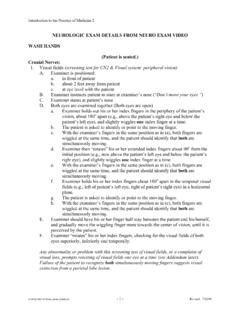

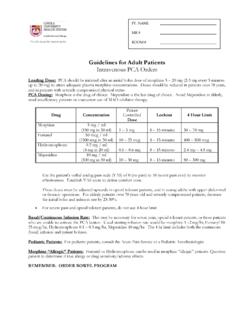

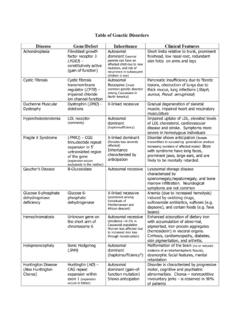

![WOUND HEALING lecture.ppt [Read-Only]](/cache/preview/2/b/6/c/1/4/7/f/thumb-2b6c147f08025508ccf4ec201274f3ba.jpg)
